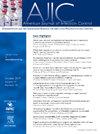成为手部卫生英雄:实施感染预防和控制运动,促进患者和家属的医院安全。
IF 3.8
3区 医学
Q2 INFECTIOUS DISEASES
引用次数: 0
摘要
背景:COVID-19 大流行突显了手部卫生是预防医疗相关感染的关键。患者和家属是感染预防和控制实践中未被充分研究的对象。以往旨在改变手部卫生行为的活动效果显著,但在实施过程中往往面临系统性挑战:方法:"手部卫生英雄 "教育活动旨在改善两家三级儿科和产科医院的患者和家属的手部卫生状况。活动分为多个阶段,包括视觉材料、为九个医院单位量身定制的活动以及为期两年的长期评估。通过直接观察,在基线和整个活动期间对患者/家属和医护人员的手部卫生率进行了测量:结果:总体而言,病人/家属(OR 1.82,P 0.041)和医护人员(OR 2.15,P 讨论)的手卫生率都有明显提高:干预的持续时间、活动的简单性、参与的积极性以及资源的可用性可能会影响活动的成功。积极的预后因素包括来自行政部门和一线员工的混合领导支持、预先确定的可持续发展计划以及根据目标受众量身定制的活动:医院教育活动的实施可能需要大量资源,但却能对患者和家属的手部卫生产生积极影响。本文章由计算机程序翻译,如有差异,请以英文原文为准。
Becoming hand hygiene heroes: Implementation of an infection prevention and control campaign for patient and family hospital safety
Background
The COVID-19 pandemic highlighted that hand hygiene (HH) is key in preventing health care-associated infections. Patients and families are understudied targets for infection prevention and control practices. Previous campaigns to change HH behavior have been effective, but often face systemic challenges with implementation.
Methods
The “Hand Hygiene Heroes” educational campaign was developed to improve patient and family HH at 2 tertiary care pediatric and obstetrics hospitals. Its multiple phases included visual materials, tailored activities for 9 hospital units, and long-term evaluation during a 2-year period. HH rates among patients/families and health care workers were measured at baseline and throughout the campaign via direct observation.
Results
Overall, HH significantly increased for both patients/families (OR 1.82, P .041) and health care workers (OR 2.15, P < .001) after campaign initiation. However, individual units had varying degrees of sustainment on follow-up evaluations.
Discussion
Duration of intervention, activity simplicity, active participation, and resource availability may affect success of campaign initiatives. Positive prognostic factors included mixed leadership support from administration and frontline workers, predetermined sustainability plans, and tailored activities by target audience.
Conclusions
Implementation of hospital educational campaigns can be resource-intensive but can positively impact patient and family HH.
求助全文
通过发布文献求助,成功后即可免费获取论文全文。
去求助
来源期刊
CiteScore
7.40
自引率
4.10%
发文量
479
审稿时长
24 days
期刊介绍:
AJIC covers key topics and issues in infection control and epidemiology. Infection control professionals, including physicians, nurses, and epidemiologists, rely on AJIC for peer-reviewed articles covering clinical topics as well as original research. As the official publication of the Association for Professionals in Infection Control and Epidemiology (APIC)

 求助内容:
求助内容: 应助结果提醒方式:
应助结果提醒方式:


